Montessori Long Division: How to Use Racks and Tubes (+ Sample Question)
Seeking a comprehensive guide to mastering Montessori’s long division material? Look no further! With my expertise in Montessori elementary, I’ll walk you through using racks and tubes for simple division.
By the end, you’ll grasp the incredible potential of this material. Your confidence will soar, empowering you to deliver the long division lessons your students crave.
But before I can teach you how to use the Montessori racks and tubes material, let’s start with the basics, like what is division anyways?
What is Division
Ah, division – the act of separating things into equal parts. One of the four basic math operations, and the one that I inform my students is the most polite. It is after all always giving a fair result of sharing.

This operation is the inverse, or opposite, of multiplication. It’s also something that is oftentimes avoided by elementary-aged mathematicians everywhere.
But with the use of the Montessori division material, this daunting mathematical operation becomes more tangible!
Montessori Long Division Material: Racks and Tubes
Racks and tubes, also known as division boards or test tube division, is a Montessori material used to teach long division.
An important part of the 6-9 math curriculum, the hands-on element of this math material gives a concrete understanding of the abstract concept of division.
Complete with many tiny pieces and purposefully colour-coded parts, it is one of my absolute favourite tools to teach math. Sure, this long division material may seem intimidating, but that’s the beauty of it.
I love how complicated it appears and how quickly young elementary students grasp the concept. It’s a magical piece, I’ll vouch for that!
The racks and tubes division material is great for working with larger numbers and forming the bridge to abstraction.
Using division boards helps children experience and understand more thoroughly how numbers are manipulated and exchanged during long division.
Parts of Racks and Tubes
There are many components to this complex Montessori long division material. When looking at racks and tubes this is what you are seeing:
The colour scheme of red, blue, and green is representative of the number family hierarchy. The colour coding of green for units, blue for tens, red for hundreds, and green for thousands is consistent throughout many Montessori materials.
This familiarity allows the learner to feel as if they already know something about the task.
Racks and Tubes for Big Work in Division
This Montessori long division material allows students to work with a single-digit divisor, double-digit divisor, triple-digit divisor, or even a quadruple-digit divisor.
They can practice static division and dynamic division, questions with and without remainders, and learn how to record all of their work.
In short, big or small, great work can be done with the racks and tubes material. Teaching long division with a Montessori division board makes math make sense!
Racks and Tubes in Motion
Want to see the Montessori division material in action? Check out this stop motion of a single-digit divisor division question featuring our printable racks and tubes material.
Montessori Long Division Sample Question Walkthrough
Now, let’s walk through the question 6748 ÷ 3 together and break down the steps to dividing as we work through it. Hopefully, this outline will help you feel more comfortable and confident when giving the racks and tubes presentation.
The Division Question:
Here is the question, get ready it’s a big one!
6748 ÷ 3
This question is asking how many times three fits into 6,748. But before we go splitting things up here, (pun intended!😂) let’s review the parts of a division question – the divisor, dividend, and quotient.
Parts of a Division Question
I think it’s really important to use the proper terminology with elementary students as it brings a level of sophistication to the learning as well as a deeper understanding of what they are working with. Also, the word quotient is just fun to say!
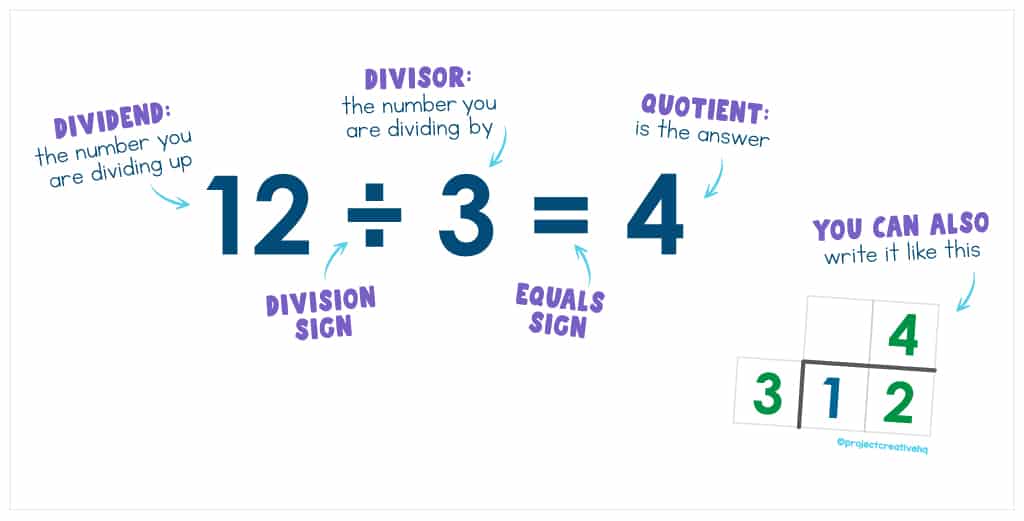
The perfect resource for your in-class or digital Montessori elementary math curriculum.
I believe sharing precise language typically unknown by the general population is always the way to go with elementary students! This type of information energizes their minds and get’s them excited about language while they learn math.
Read more about unique vocabulary development activities for the elementary level and why they are important.
Build the Question Using the Montessori Long Division Material
It’s time to build the question. Gather your long division materials and follow along as we solve a single-digit divisor division question using racks and tubes.
Don’t have the racks and tubes material? No problem! We created a digital and a printable version because we wanted to make this legendary Montessori math material accessible to everyone. This tool for teaching long division can be pricey, so check out our shop for budget-friendly alternatives.
A Look at the Montessori Long Division Materials
Here is a visual of all the pieces involved in the Montessori racks & tubes set up. The terms outlined here are used throughout the instructions on how to use this material, so it’s important to familiarize yourself with these words.
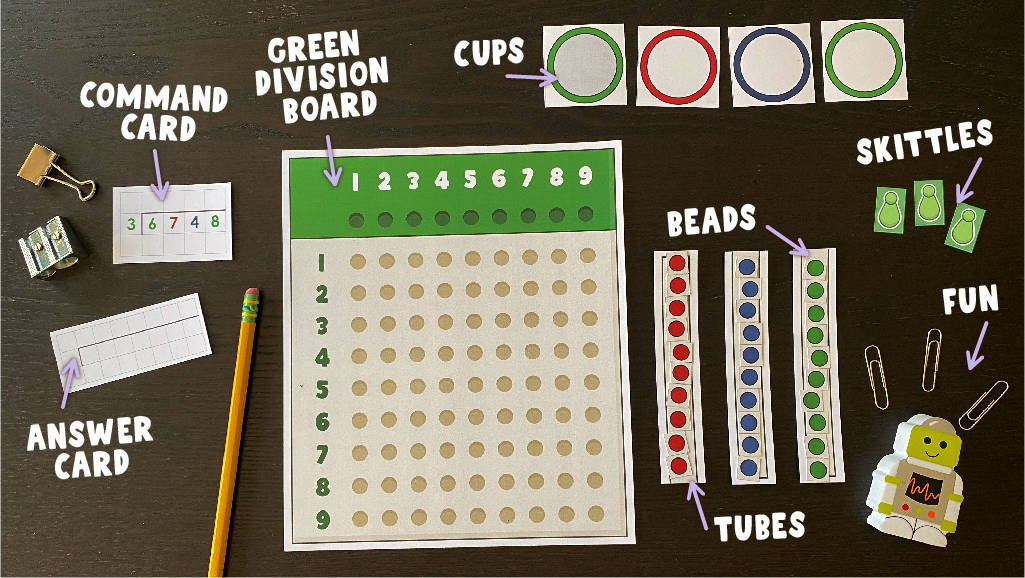
What Goes Where?
When presenting a lesson using the Montessori long division material be sure to be consistent in your setup and layout of racks and tubes.
The division board should be front and center with a question displayed on a command card or written in a notebook close by to either side of the division board or even below it.
The appropriate amount of skittles needs to be placed on the division board. The skittles go under the numbers written horizontally at the top of the division board. After that, the remaining skittles can be stored away.
The colour-coded cups that are filled with beads that make up the dividend should be above the board and over to the right a bit. I like to line the largest number family up with the number eight on the division board. This gives students room to move each cup down to the division board when dividing begins.
It’s always good to have several tubes filled with colour-coded beads next to or above the division board. Just make sure that each tube holds ten beads of the same colour. That will be helpful when exchanging takes place.
Ok, now you’re ready to divide!
How to Set Up a Question Using the Montessori Division Materials
Every division question is made up of a dividend and a divisor. But which is which? We’re here to clear the air with this helpful visual.
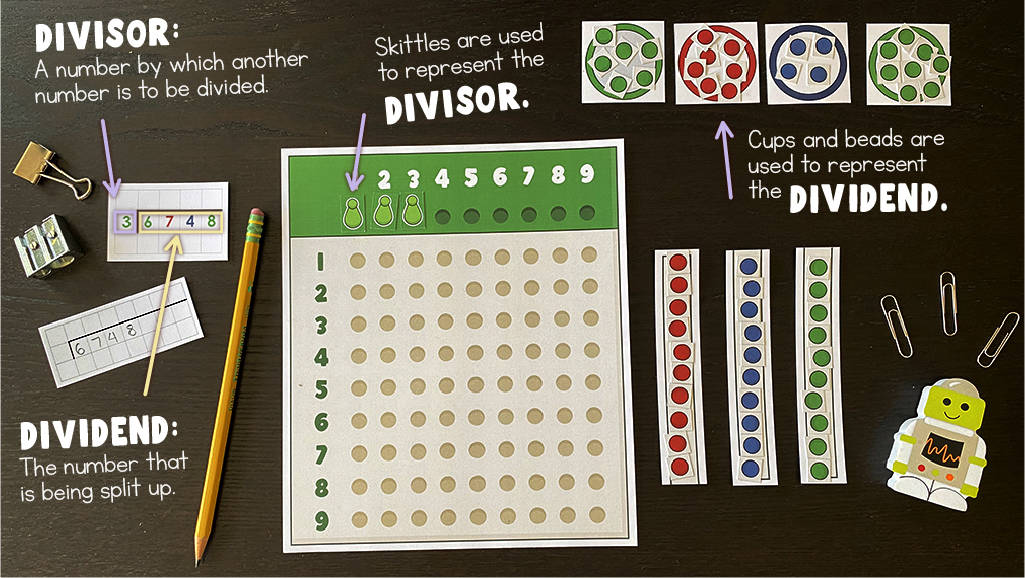
Here’s the question again:
6748 ÷ 3
In this case, six thousand seven hundred forty-eight is the dividend, and 3 is the divisor.
I like to set up the dividend first.
To build this number we will use coloured-coded beads and their respective cups.
For this question, you’ll need:
• six green beads in a green cup {with a grey exterior} (thousands);
• seven red beads in a red cup {with a white exterior} (hundreds);
• four blue beads in a blue cup {with a white exterior} (tens);
• eight green beads in a green cup {with a white exterior} (units).
Your cups should look like this:

Six thousand seven hundred forty-eight. That’s our dividend.
Now time to build the divisor.
Since we are working with a single-digit divisor, we only need the green division board to represent the unit family.
Get those skittles ready! Three green skittles are needed to represent the divisor. We use green skittles because we are working with a single-digit divisor, 3. Or we could say our divisor only consists of the unit family.
Place the skittles on the division board, below the horizontal numbers outlined at the top of the board.
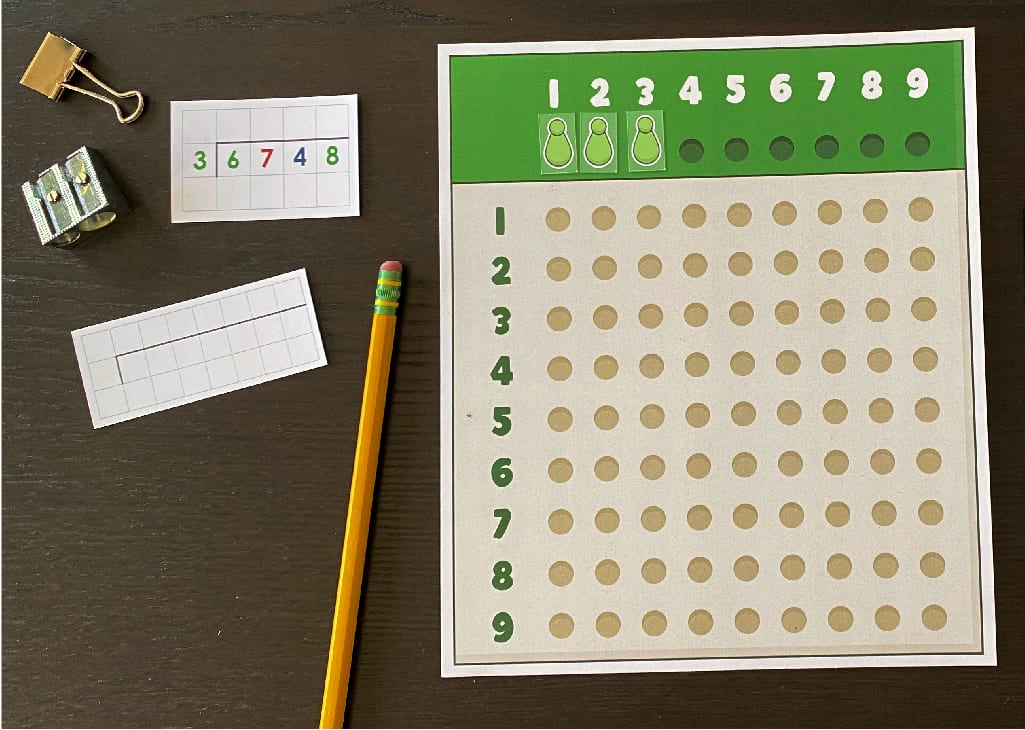
FUN SIDE NOTE: Students love to talk about the skittles! They want to know more about them and of course want to relate them to the candy, Skittles. Take the time to expand on their curiosity and engage in these fun conversations. It’ll make this math lesson much more memorable!
Time to divide!
When dividing, you always start with the largest number family of the dividend and work your way down to the unit.
For this question, the thousand family is as large as it gets. Bring that green cup, beads in tow, down to the division board. The thousand cup toting six green beads can be placed above or on the division board. Yay for prepositions!
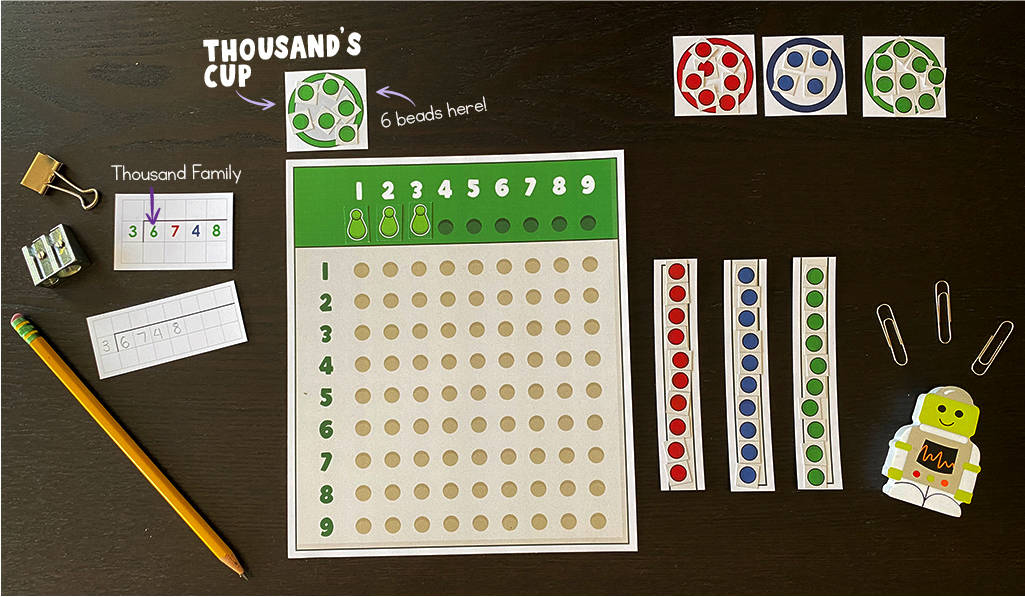
Next, share the beads in that cup evenly across the board with the three skittles. It’s important to always move horizontally across the board when sharing, making sure that each skittle receives an equal amount of beads.
Once each skittle has received a bead you can move down to the next number row. In this case, each skittle gets two green thousand beads.

Don’t forget to record your answer. Since we are working with the beads in the thousand family cup, we record the two in the answer space above the thousand’s place in the question. Great work!
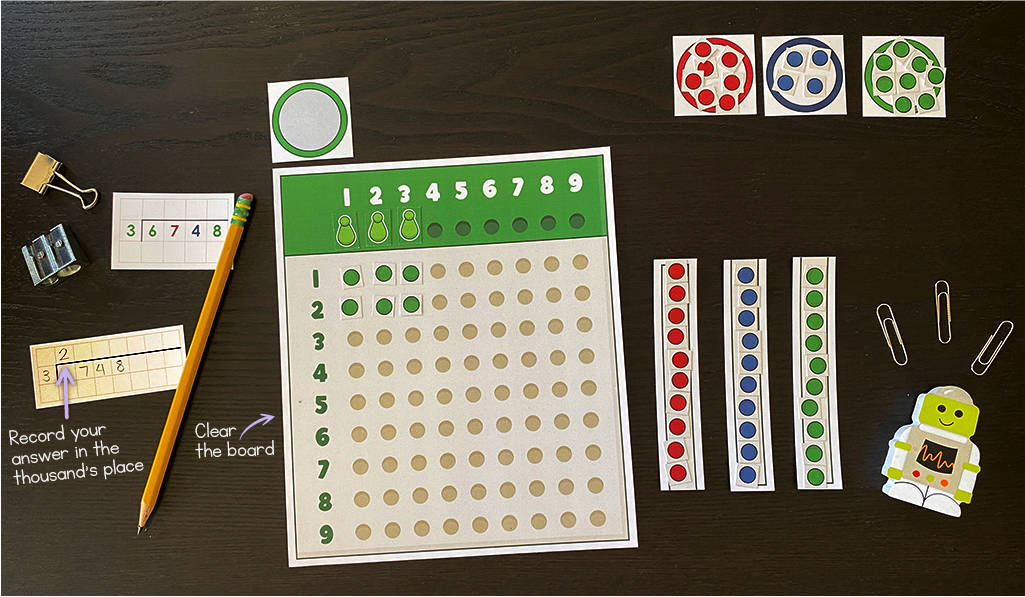
Now that we’re done with the thousand family, we need to clear the board of beads to get ready for the next round of sharing.
Move the thousand beads and the thousand cup to the side. Cleaning off the board is a crucial step here and the perfect opportunity to stress the importance of cleaning up. A tidy place is a happy place! Teachable moments are everywhere!
So here we are, dividing a really big number and actually seeing the process unfold. Amazing!
Now it’s time to bring down the cup of the next largest number family from the dividend down to the unit board. That’s the hundred’s cup!
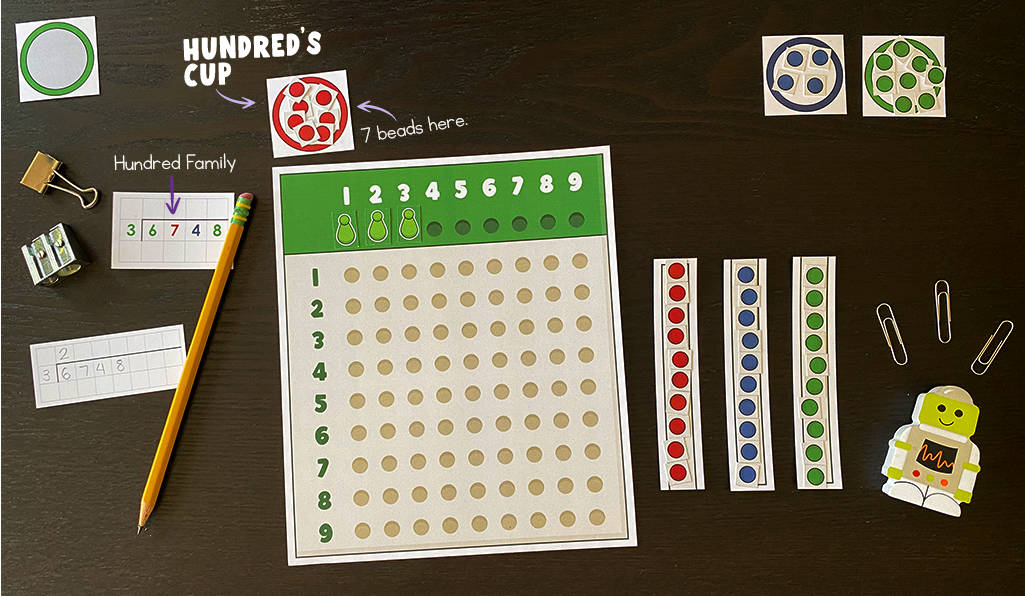
Then, following the same horizontal sharing strategy as above, we are going to give one red hundred bead to each green skittle until it is impossible to share evenly. The keyword here is ‘evenly’.
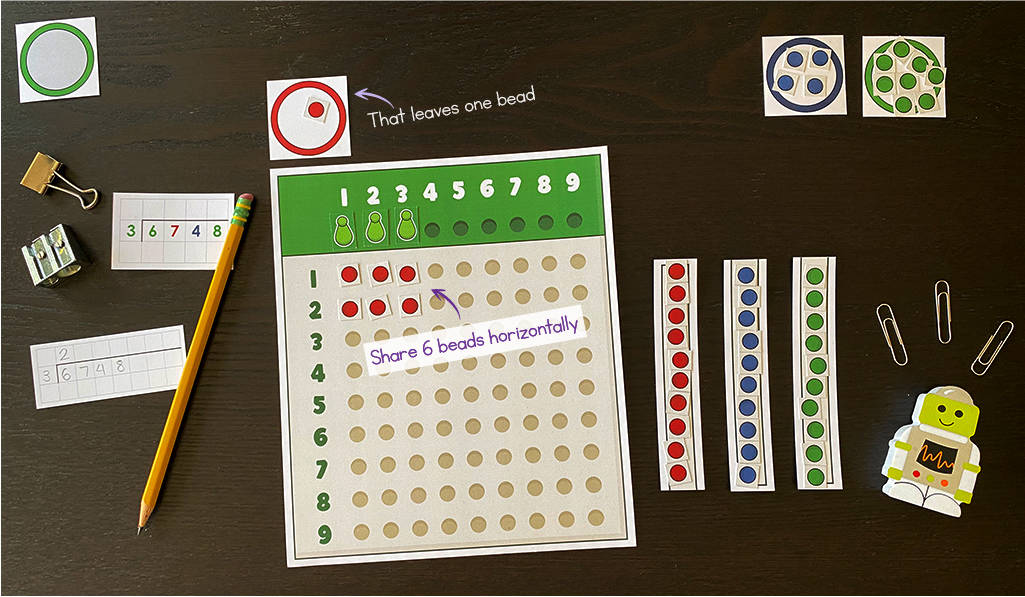
But what about that precious little leftover red bead you ask?
It’s time to exchange!
Remember that one red hundred bead represents 100 and therefore can be exchanged for ten blue ten beads. Get one tube filled with blue beads (double check that there are in fact ten beads in that tube!) and empty it into the ten’s cup. The lonely red bead can go back into a tube now.
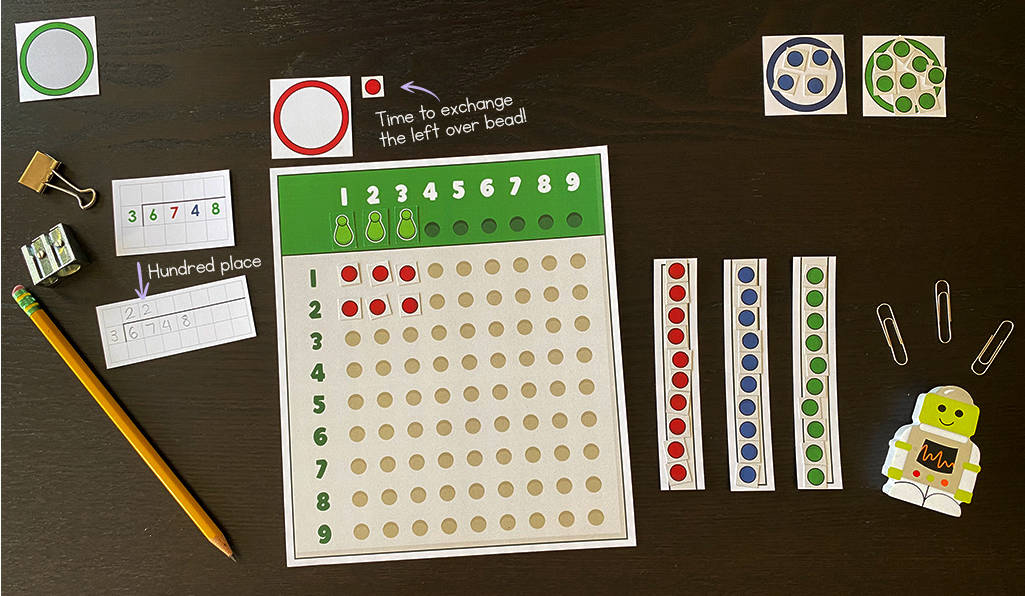
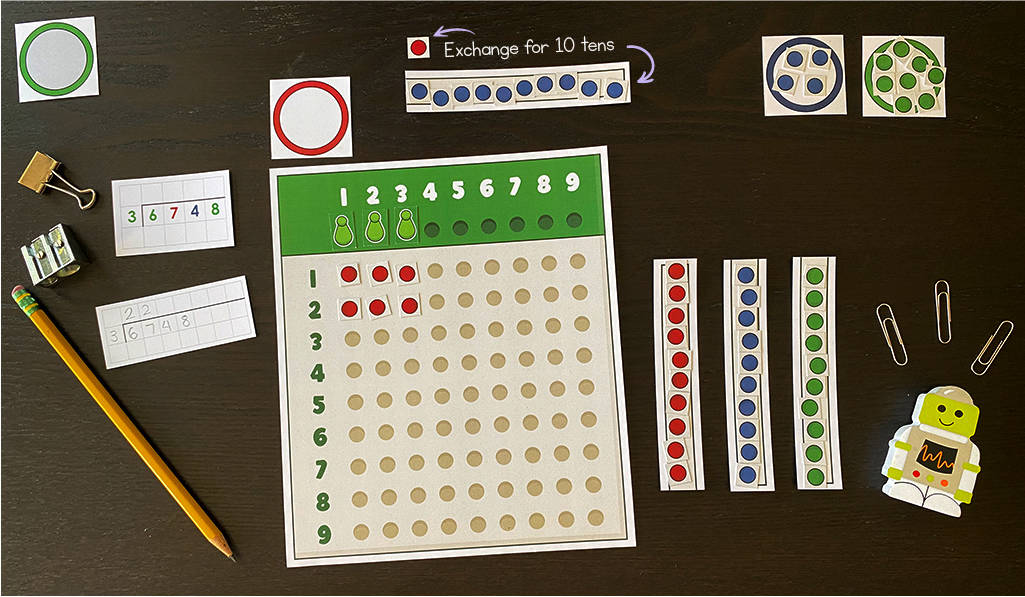
You know, I really respect just how gracious division is. Not only is it giving but it is also supportive and understanding of others in need!
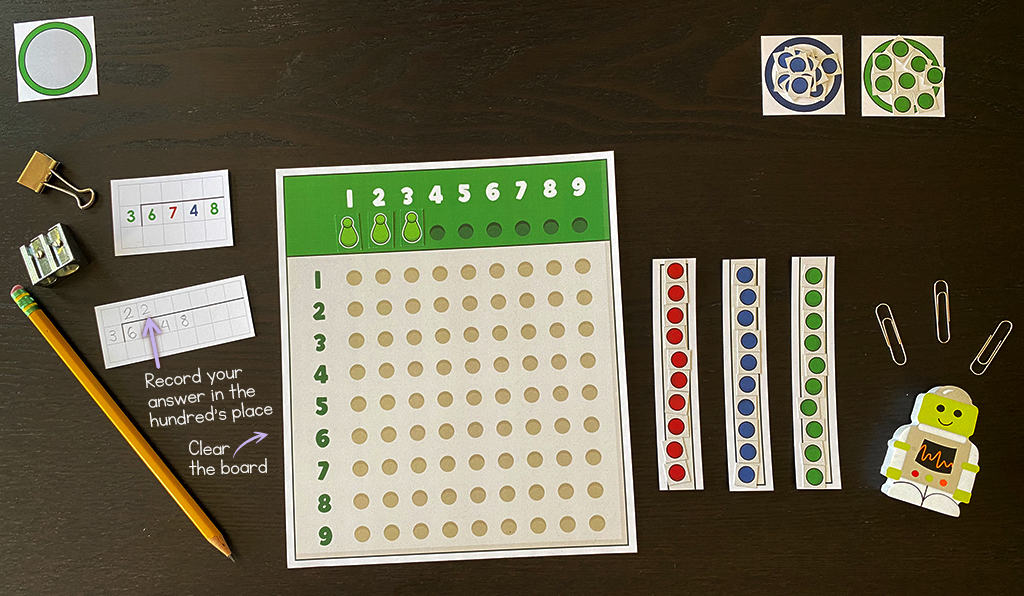
Wait! Don’t forget to record your answer. Since we are working with the beads in the hundred family cup, we record the answer in space above the hundred’s place in the question.
So now your hundreds cup is empty, mission accomplished!
The board has been cleared of red beads and it’s time to move that red cup out of the way.
We’re halfway there!
The ten’s cup is next!
The great thing about division, and math in general, is that you’re really just following rules and patterns.
With that in mind let’s continue by repeating what we’ve already been doing, but now with the beads of the next largest number family, the blue cup overflowing with blue beads representative of the ten’s family.
Bring that blue cup down to the unit board and do what you have learned to do so graciously.

Share! Dole out those blue ten beads to see what each skittle receives.
Record the result and take note of any leftover beads.
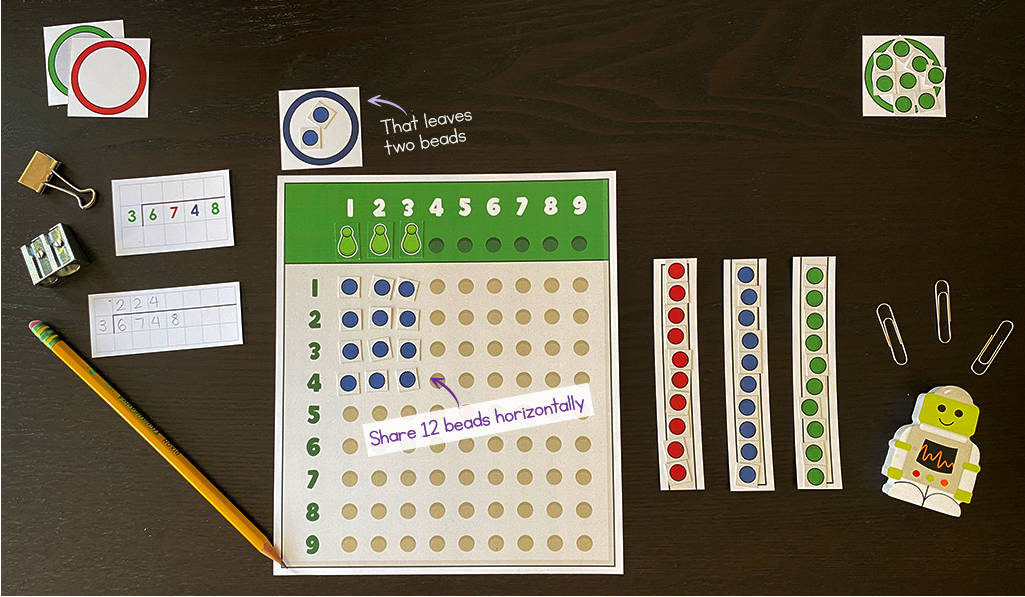
You know what to do next!
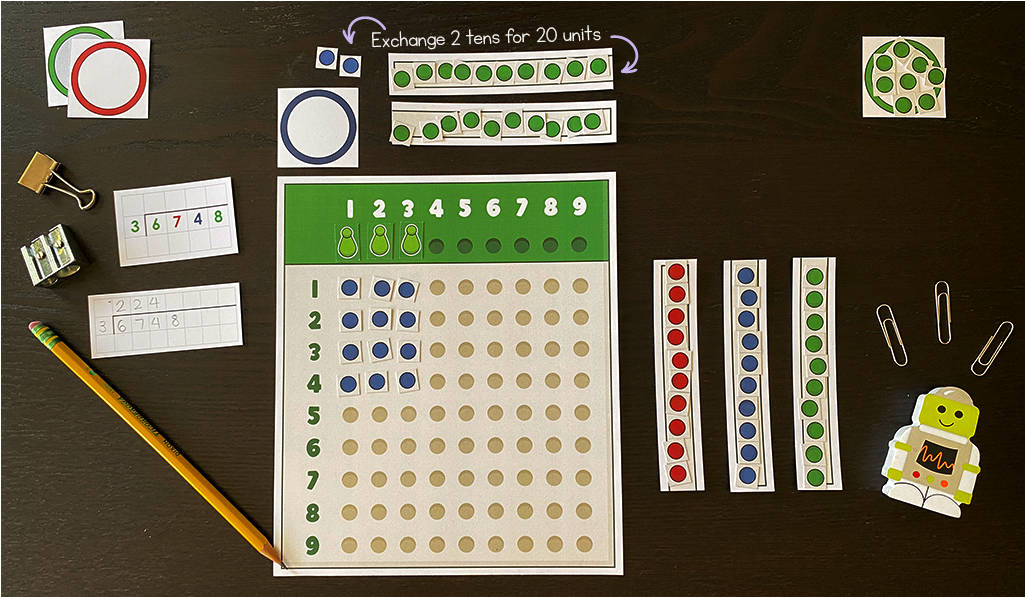
Exchange those two leftover beads. Add twenty green beads to the green unit cup and put the two leftover beads back into a tube. Now your blue cup is empty and your green cup runneth over.
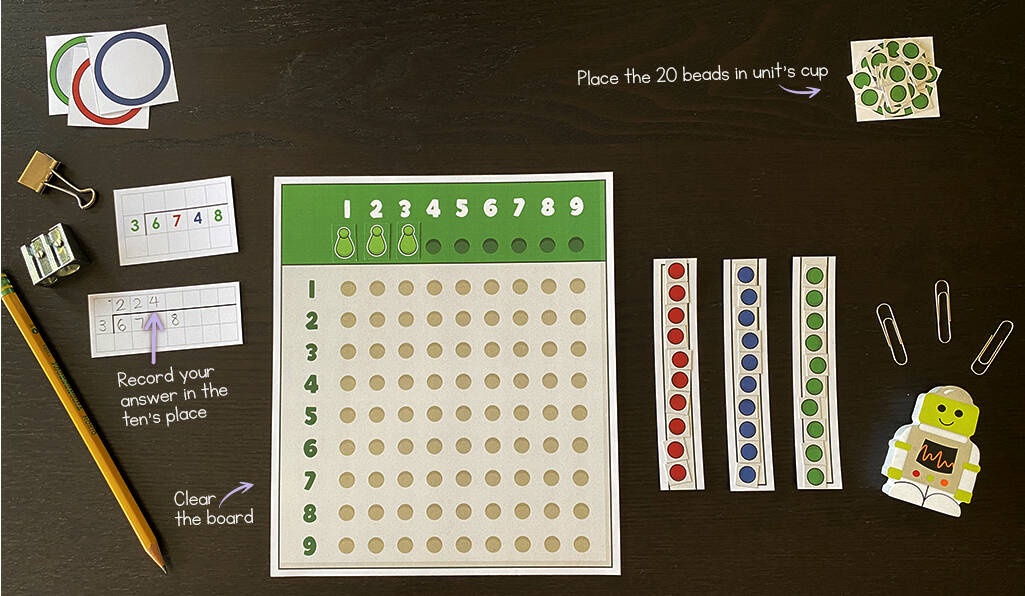
Clear that board and move the blue cup to the side. It’s time for the last bit of sharing.
Now would be an excellent time to have learners guesstimate what the answer might be. Do they think the answer will fall closer to 2,243 or 2,248? This is a good opportunity to explore math in a fun way. It’s also a great teachable moment!
Finally, the unit cup.
Here we are, about to unveil the answer. Let’s take a moment to appreciate the racks and tubes material for offering a great deal of repetition without being a worksheet drill. High five! ✋
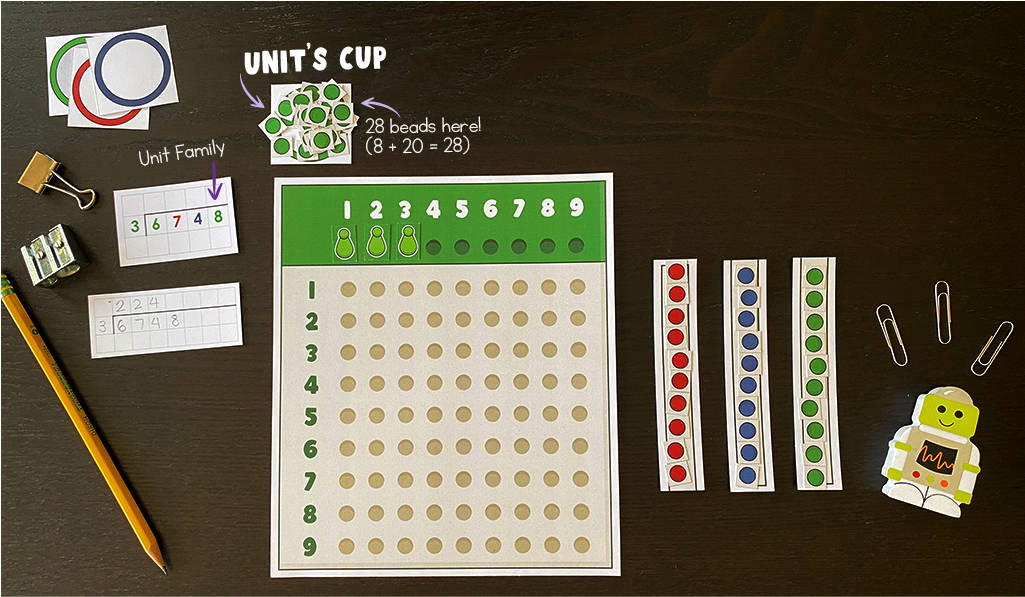
Now go ahead and share all of those green unit beads with the three green skittles. How many does each one get?
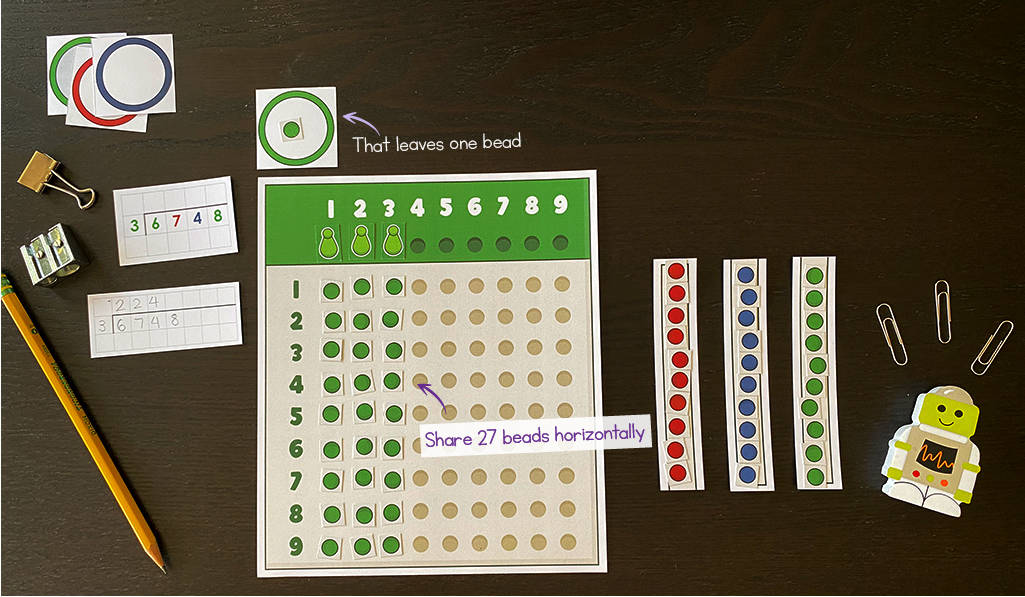
Are any beads leftover? Don’t worry, it’s ok! The remaining beads are called the remainder. How fitting! This is what does not fit evenly into the dividend and will always be smaller than the divisor.
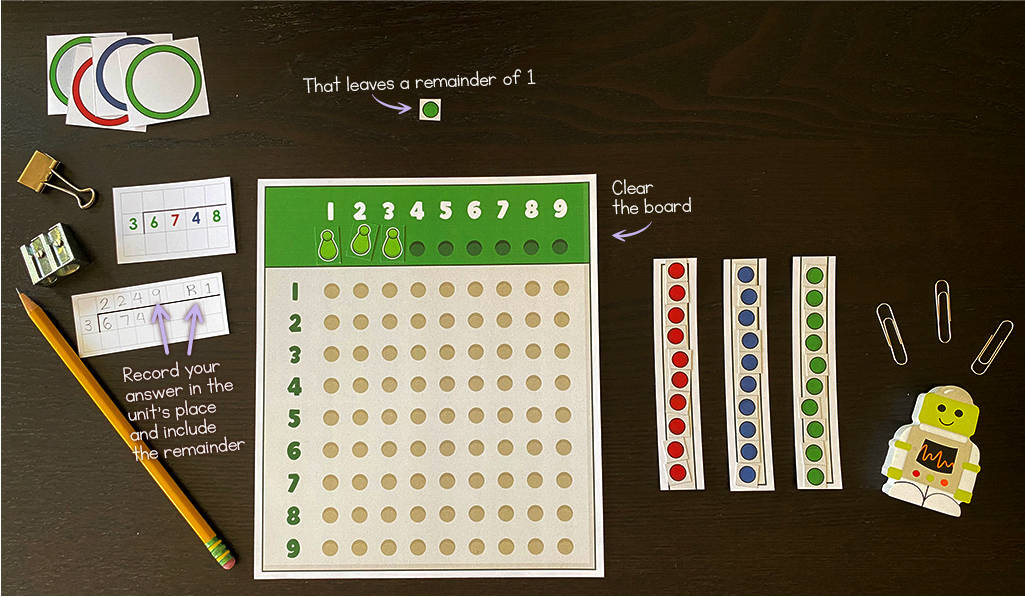
Record the answer.
But what about that extra bead? It’s part of the answer too you know! Make sure that students include the remainder beside their answer.
Now that everything is accounted for the division board can be cleared of beads and the green cup moved to the side. All sorts of cleaning going on in this math lesson!
Montessori Long Division Success!
We now have the final answer and a deeper, more tangible understanding of how this Montessori math material works. Good job!
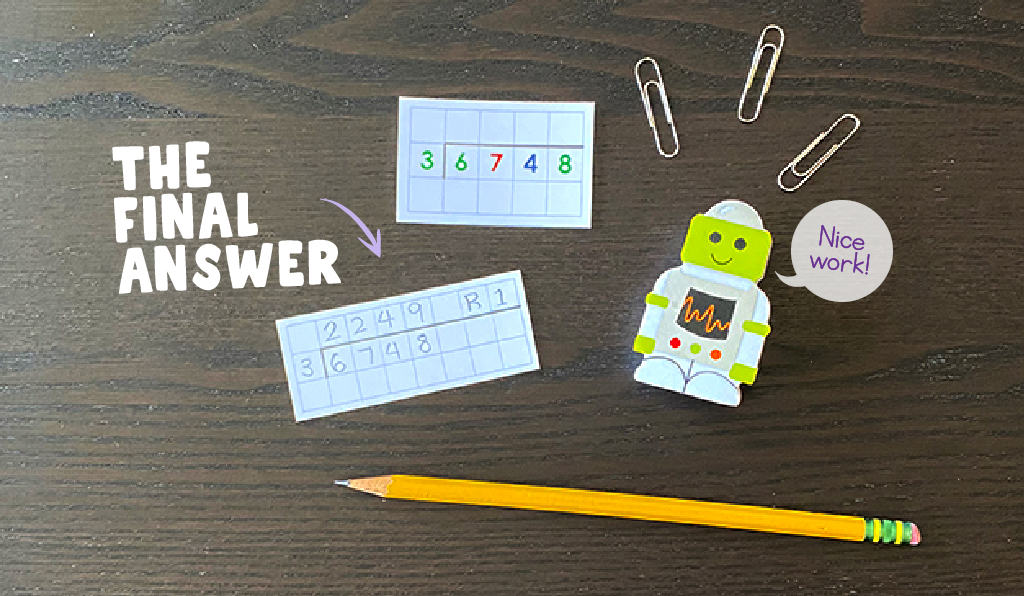
Now you can see just how helpful it is when the senses are engaged in the learning process. Racks and tubes, or test tube division, really does make division easier to grasp.
Montessori Students Learn Division in Lower Elementary
There’s a bit of a difference between when division is introduced in Montessori vs traditional school.
In the traditional school system division enters the math curriculum in the middle of elementary school, around the age of eight which is about grade 3 or 4.
However, in a Montessori environment, young elementary students are introduced to the story of numbers through the fifth Montessori great lesson. This introduction opens their eyes to the wonder of numbers.
This presentation allows students the ability to explore division concepts quite a bit earlier, even as early as five years old. Talk about building their confidence and excitement at an early age!
Such abstract learning is made possible with the help of the Montessori math materials.
From a young age, learners are able to literally grasp the concept of division because they get to experience it with their hands using concrete materials that connect the hand and the brain. Amazing!
It is hands down one of my favourite math materials and a great tool for teaching division in the elementary classroom.
Also referred to as test tube division, this long division material uses division boards, beads, and skittles (not the candy!) to help students understand division through repeated activities using their hands.
BONUS, This material really is for all ages! Yes, adults benefit from this material too!
In order to get Karen, the designer of all things That’s So Montessori, to create the printable racks and tubes material I had to teach her how it works.
I walked her through the ins and outs of the material and had her explore independently with some questions.
Her understanding of division was heightened because rather than just looking at numbers on paper and attempting to split them up, she was able to have a visual and physical connection to the abstract concept of division.
As a creative person, this math material really aligned with how she learns.
Side Note: You’ll be happy to know that Karen also benefited greatly from our comprehensive guide to the 8 parts of speech. You should check it out!
The racks and tubes division material builds upon previous Montessori math materials. After practicing single-digit division using the golden bead material and the stamp game, the division boards are introduced to the elementary student.
This is the type of work where students gain more than just math skills. They learn about patience, how to work independently, and the importance of cleaning up after themselves.
That’s so Montessori!
Consider using fun math activities for your elementary learners after, or even during, a division lesson. My students thrive when they are able to explore a concept further with games.
Check out our long division lessons with me, Teacher Donna!
Watch our breakdown of a double-digit divisor division question using our digital racks and tubes Montessori division material, where we will put two Montessori division boards to the test. You and your elementary learners will love it!
Want to know how to use the Montessori chequerboard (checkerboard) to teach multiplication?
We provide a walkthrough of our digital chequerboard material in our blog Montessori Checkerboard: A Guide to Multiplication. It’s perfect for any elementary classroom!
The Wrap-Up: Montessori Long Division
I believe that the Montessori long division material would be beneficial in any elementary classroom. Hopefully, the sample question gives you a more tangible idea of how to present this lesson.
Yes, the racks and tubes material looks complicated, and at first, it kind of is. But it is an important part of the bridge to abstraction in long division that shouldn’t be skipped over.
This material provides students with a hands-on experience when learning long division. As a result, it also helps children build confidence in working with numbers, and best of all it’s a lot of fun.
Keep your kids busy learning with these educational activities:
11 Ways to Use Our Roll A Story Dice Game
13 Engaging Vocabulary Development Activities for Elementary Kids
Rebus Puzzles for Kids: A Comprehensive Riddle-Solving Guide
31 Fun Summer Reading Activities Elementary Students Will Love
The Best Neighborhood Walk Scavenger Hunt & 13 Different Ways to Use It
8 Easy Rebus Puzzles with Answers
Rebus Puzzles for Kids: A Comprehensive Riddle-Solving Guide
27 Educational YouTube Channels to Prevent Summer Learning Loss


